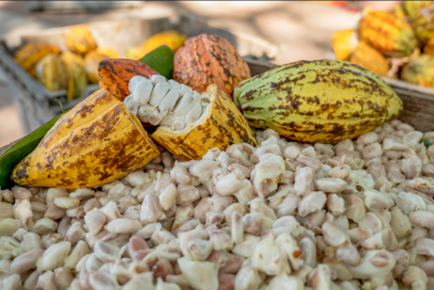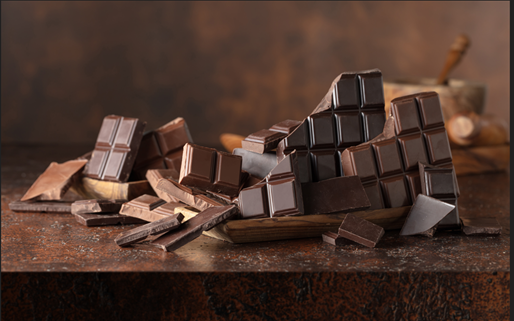Cocoa percentage, bean variety, country of origin… These criteria are important when choosing a chocolate bar, but they don’t determine its quality. The aromatic profile, flavor and texture of a chocolate depend largely on the proper fermentation of the cocoa beans it contains.
Understanding the cocoa fermentation process
The cocoa bean is a fruit with a naturally bitter taste. It’s thanks to a multi-stage treatment process that it obtains the taste it’s known for.
Key stages in the process: shelling, fermentation, drying
Once harvested, the cocoa pods (the fruit of the cocoa tree) are opened. The beans are extracted, sorted and placed in wooden crates, usually covered with banana leaves. This is when the fermentation process begins. It lasts between two and seven days, depending on the region’s climate and the desired fermentation characteristics.
The beans are then sun-dried, roasted and ground with sugar and sometimes powdered milk, to form chocolate ready for shaping.
Biochemical reactions during fermentation
Each farmer has his or her own method for fermenting cocoa beans, but the biochemical reactions involved remain broadly the same. They involve three types of microorganisms: yeasts, lactic acid bacteria and acetic acid bacteria. These communities break down the sweet pulp around the beans, producing metabolites such as amino acids, organic acids and aromatic compounds. These chemical reactions remove the bitter taste from the bean and form the flavors of cocoa: acidic, fruity, spicy, honey, caramel, floral aromas, etc.
- Yeasts carry out alcoholic fermentation by breaking down the pulp.
- At the same time, lactic acid bacteria consume pulp sugars (fructose then glucose), generating lactic acid, acetic acid, ethanol, carbon dioxide and other metabolites.
- The ethanol produced by the yeast is used by the acetic acid bacteria to transform it into acetic acid when oxygen enters the fermenting mass.
- The temperature of the fermented mass rises.
- The high concentration of acetic acid and the temperature contribute to lowering the pH and killing the seed embryo.
- This triggers a series of biochemical changes in the bean that affect its taste and color.

The impact of fermentation on chocolate taste and quality
Fermentation of cocoa beans is the stage in the process that gives chocolate its flavor, aroma and texture. The microorganisms that play the most important role in this process are yeasts. First and foremost, they play a functional role, contributing to the antioxidant and antimicrobial properties of the beans. The yeast strains present during fermentation will also define the sensory characteristics of the chocolate. Their diversity will determine its flavors and aromas.
Good fermentation guarantees cocoa with pleasant flavours. Conversely, badly fermented beans will give chocolate an unpleasant taste. Lesaffre’s teams are developing yeast strains that can be used to improve the fermentation process and the complexity of the flavors produced.
Aroma formation: acidity, bitterness and sweetness
When it breaks down the pulp surrounding cocoa beans, yeast is responsible for producing chemical compounds, a significant proportion of which are volatile organic compounds. These are the aldehydes, alcohols and esters that give cocoa beans their distinctive taste.
To achieve better results, researchers have been looking at the production of flavor precursors by microorganisms and their diffusion to the interior of the bean. Precursors such as leucine, alanine, phenylalanine and tyrosine contribute to the formation of cocoa and chocolate aromas and develop during fermentation. The compounds derived from them release all their notes during the roasting stage. They give cocoa fine aromatic notes (sweet, floral, caramel, fruity…) as well as basic notes (coffee, earth…).
Comparison of traditional and modern fermentation methods
The fermentation process can be spontaneous, in the case of traditional fermentation, or initiated using starter cultures. In the case of spontaneous fermentation of cocoa beans, the microorganisms involved are those already naturally present on the beans and in the surrounding environment. In the 20th century, industrialists sought to produce organoleptically high-quality chocolates that could be reproduced identically, in order to meet new commercial challenges. This led to research into starter cultures. This method involves adding precisely selected microbial strains to the mass of cocoa pulp and beans. The result is a final product with a more consistent quality and aromatic profile. It also makes it possible to better control and shorten the fermentation process and improve the safety of the beans.
Innovations and new practices in cocoa fermentation
Research into fermentation microbiology has enabled us to optimize this process. Researchers have identified the most useful microbial communities for high-performance starter cultures. Yeasts of the Saccharomyces Cerevisiae genus are those most often selected for optimal cocoa fermentation. At the forefront of research into these strains and their production, Lesaffre offers manufacturers solutions that perfectly meet their needs.
Use of specialized yeasts to improve bean quality
Optimized yeasts for better fermentation control, including Saccharomyces Cerevisiae, resist high temperatures, shorten fermentation times, reduce the number of poorly fermented beans, and reveal the desired aromas and flavors of the cocoa variety grown.
Sensors and monitoring of fermentation conditions
To achieve the best possible bean fermentation, controlled environments are sometimes set up. These involve the use of sensors to monitor fermentation conditions in real time: temperature, humidity, oxygenation. This advance also enables us to analyze batch fermentation data a posteriori, to guide future decision-making. This close monitoring can be coupled with yeasts specially selected to react optimally to different fermentation conditions.
Future trends in cocoa fermentation
Cocoa fermentation is still the subject of research and innovation today.
Artificial intelligence and automation in fermentation
Artificial intelligence is revolutionizing many fields, including the optimization of cocoa bean fermentation. Machines are trained to recognize the different stages of fermentation, to distinguish bean quality, to detect the presence of disease in production… An advance that could make it possible to automate and replace current cutting tests, during which an assessor determines the level of fermentation and defects in the cocoa.
Towards greener, more sustainable fermentation
The use of specialized yeasts contributes to a more environmentally-friendly fermentation process, helping to meet today’s environmental challenges. It’s a natural method that produces high yields without the use of chemical fertilizers or pesticides, and reduces waste and energy losses.
Environmental impact and sustainability of cocoa fermentation
Using yeasts specifically selected for fermentation reduces the duration and intensity of fermentation, thus minimizing the carbon footprint of the process. It also produces fewer poorly fermented beans, and therefore less waste. Finally, fermentation by-products can be used as organic fertilizers to enrich the soil of cocoa plantations. Specific yeasts can transform this waste into compost or reusable products.
Frequently asked questions about cocoa bean fermentation and processing
What role does fermentation play in the development of chocolate flavours?
The fermentation of cocoa beans by yeasts and other microorganisms releases volatile organic compounds. These give the final product its aromas and flavors.
How are cocoa beans processed after harvesting?
The beans are opened, fermented, dried, roasted and then ground.
Why is the quality of the cocoa bean crucial to chocolate?
Poor quality beans, badly fermented for example, will impart an unpleasant flavour to the chocolate. Conversely, good quality beans will give the final product a pleasant palette of flavours and aromas.
What types of yeast and bacteria are used to ferment cocoa?
Yeasts such as Saccharomyces Cerevisiae, lactic acid bacteria and acetic acid bacteria.
What are the biochemical characteristics of fermented beans?
Yeasts break down the pulp around the beans, triggering a series of biochemical changes that eventually penetrate the bean, affecting its taste and color.
Cristian Díaz-Muñoz, Luc De Vuyst, Functional yeast starter cultures for cocoa fermentation, Journal of Applied Microbiology, Volume 133, Issue 1, 1 July 2022, Pages 39-66.
Formation of aromatic compounds precursors during fermentation of Criollo and Forastero cocoa, Castro-Alayo, Efraín M. et al, Heliyon, Volume 5, Issue 1, e01157


